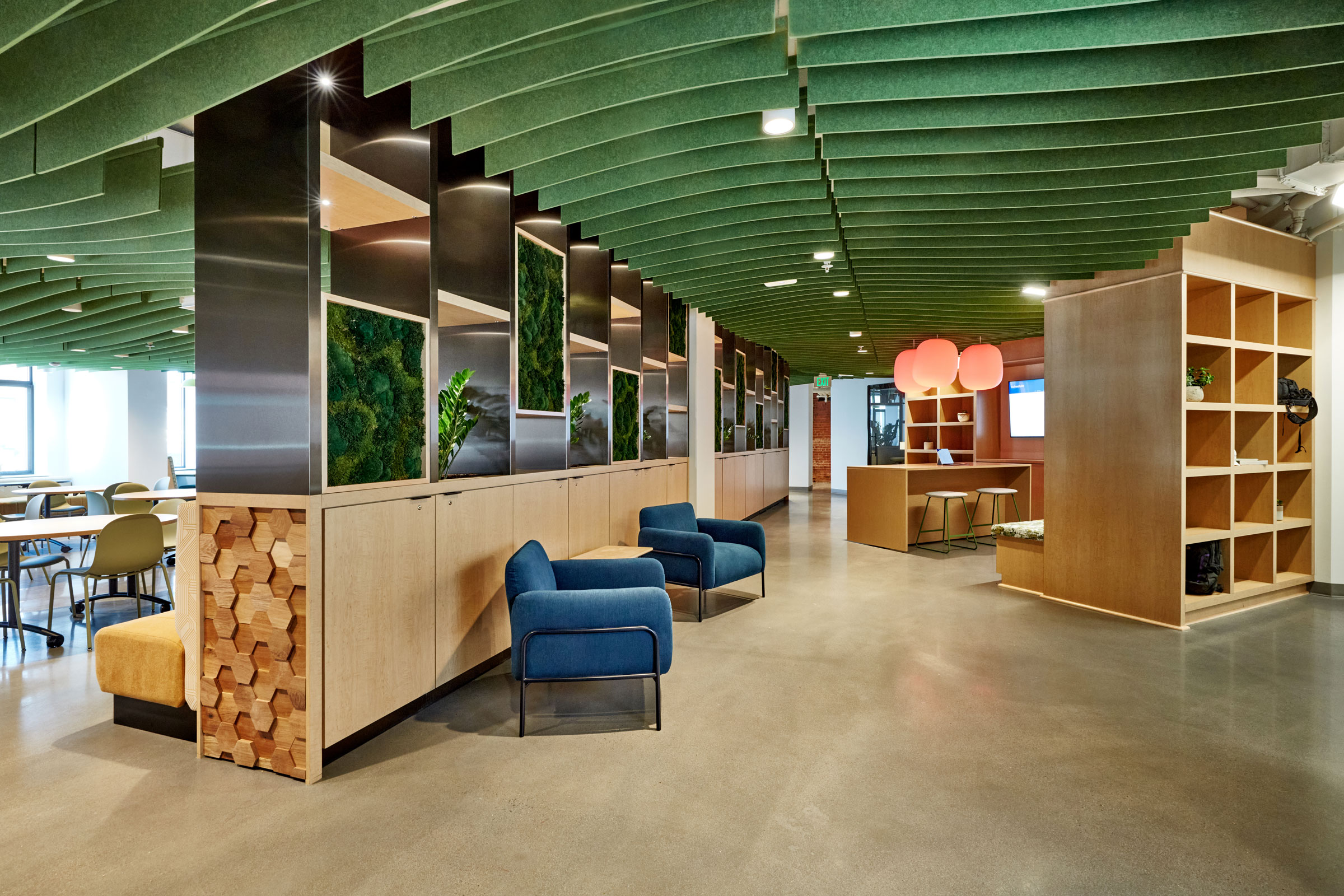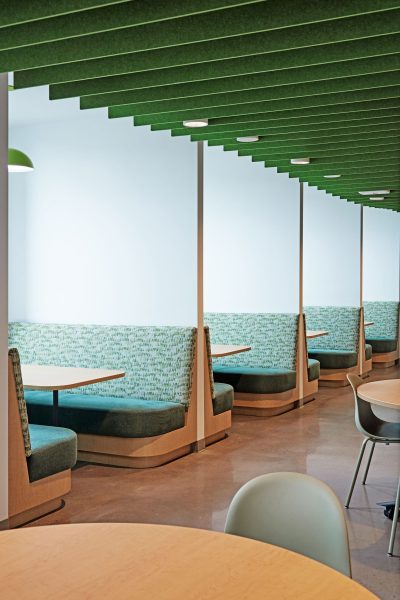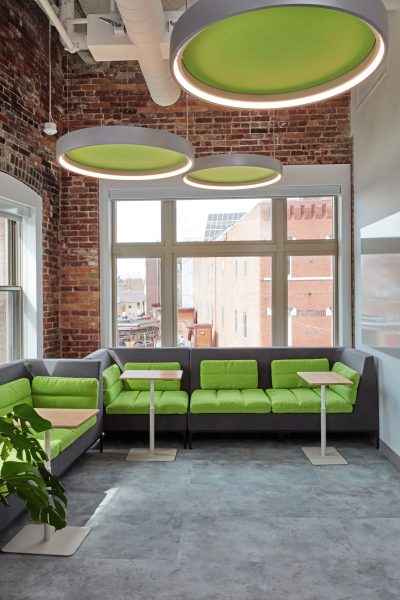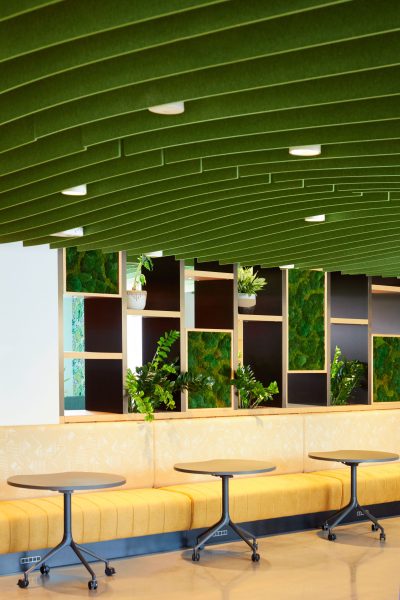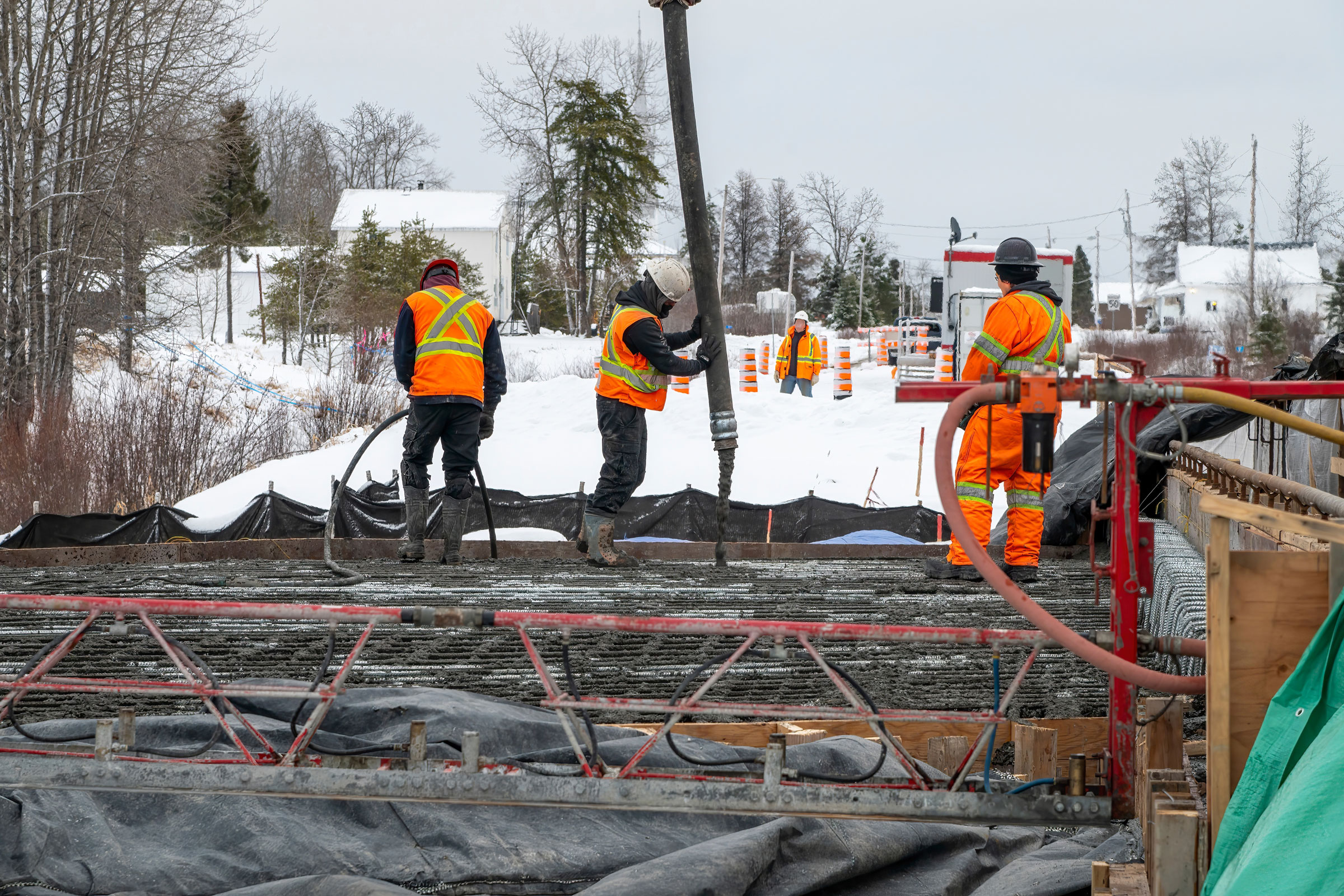Story at a glance:
- Gen Z preferences shaped Dyer Brown’s design of a new coworking space in Harvard Square that features a variety of flexible workspace configurations.
- The space includes advanced health and wellness features like ultraviolet air filtration, circadian lighting, and dedicated quiet areas.
- Materials include reclaimed wood, recycled glass and plastic, and sustainable upholstery, while bright color schemes and biophilic forms offer a nod to nature.
It takes more than good colleagues and an attractive salary to get young workers into an office. A Zoom call can’t always foster creativity, spontaneity, and camaraderie, though, so workplaces are being reconceived post-pandemic to give the best and the brightest the kinds of spaces where they can thrive.
Completed in December 2023, 20 Brattle Street is at the forefront of trends in workplace design. Emphasizing flexible workspaces and hybrid work, Dyer Brown & Associates outfitted the space to suit the preferred work styles of Generation Z—the demographic cohort that will be reshaping the professional workforce in the decades to come.
Christened The Abbot by developer Regency Centers, the 16,000-square-foot space spans the upper floors of three adjacent buildings—two historic—at the center of Harvard Square in Cambridge, Massachusetts. Designed to attract young talent and startups to its sustainably designed coworking suites, it’s almost an extension of the Harvard and MIT campuses.
The design “supports the culture and workflow of the kinds of forward-thinking organizations members of Generation Z overwhelmingly say they want to work for,” says Sara Ross, who led the 20 Brattle Street project as principal and director of Enterprise Services at Dyer Brown. “It’s built to collaborate.”
What Workers Want
- Photo by Chris Rogers
- 20 Brattle Street gives young professionals an office environment that’s flexible and sustainable. Photo by Chris Rogers
Young workers are looking for professional development and growth and prefer a flexible work environment that encourages interaction. “People—and in particular, Gen Zers—are looking for a variety of places to work in the office and communicate and be seen and see other people,” Ross says.
The Abbot offers spaces that can be configured quickly to meet a variety of workplace needs. There are private offices, shared offices, formal conference rooms, and informal huddle spaces. There are phone booths for calls, pits for open collaboration, and a fully soundproofed podcast studio.
“There’s a wide range of space types that can be used wherever your day takes you,” Ross says. “If you want to have a one-on-one mentoring, you can do that in one of the smaller rooms. But if you’re having a huddle with your peer group or team, you can go to a room that holds five, six, seven, or eight people.”
Rooms offer seating options including desks, chairs, lounges, and even beanbag chairs to allow employees to choose what’s most comfortable for them and the task at hand. Most offer flexible configurations and height-adjustable surfaces. Webcams, monitors, and whiteboards support scheduled meetings and spontaneous breakouts alike.
“20 Brattle Street really is meant for you to get out your marker and start putting a quadratic equation on the board or figuring out the next best thing someone’s going to invent,” Ross says. “Having that capability anywhere you go was really important when we were building out the space and design.”
Wellness at Work
- A glowing circadian orb above the conversation pit at the point of the building makes it look like a shadowbox after dark. Photo by Chris Rogers
- Biophilic elements include an undulating acoustic baffle made of recycled PET plastic felt from Turf. Photo by Chris Rogers
Dyer Brown launched its work on the project with a strategy session, asking local students, entrepreneurs, and other likely users to weigh in on the amenities they want in an office space. “We conducted a bunch of surveys to get feedback on what was going to go in the building and why,” Ross says.
Survey respondents also expressed a desire for a workplace that protects health and wellness. Dyer Brown specified enhancements to the interior environment such as far ultraviolet air sanitizing technology. “The amount of filtration is almost like having a constant breeze in your space,” Ross says.
Ceilings and walls limit noise with acoustic panels and sound-dampening construction. Undulating acoustic baffles of recycled PET plastic from Turf run throughout the common areas, further squelching echoes. And an appreciation for neurodivergent workers led Dyer Brown to include dedicated quiet spaces.
A Japanese-inspired reception area invites visitors to remove their shoes, minimizing ambient noise and adding to the calm. A living wall of moss and potted plants sets off a multipurpose café/event space that features reclaimed-wood accents.
Materials meet a near-vegan and ethically sourced standard. Most wood surfaces are crafted from reclaimed wood. The concrete countertop in the kitchenette incorporates recycled glass. And Dyer Brown opted for wool upholstery over leather or vinyl. “Everything is sustainable and rapidly renewable,” Ross says. “Sheep need haircuts, too.”
Circadian lighting gradually dims after business hours, providing enough “tuned” light to continue working, but preventing late-night brainstorming sessions from interfering with sleep schedules. “The building is telling you that maybe you should get some rest,” Ross says.
The design aims to “spark wonder” with bright, unexpected color combinations and natural textures. It’s like a high-end spa crossed with a Nickelodeon set—a place industrious young disruptors can enjoy creating.
“We wanted to make sure there were lots of nods to nature,” says Samantha Worth, interior designer. “Little pops of color that are found in nature are the key elements. We have these pockets of hot pink that are a nod to flowers in the environment—a really hot magenta or a millennial pink.”
Biophilic elements can make traversing 20 Brattle’s urban interiors seem like a walk in the woods, Ross adds. “You’re kind of experiencing being in nature,” she says. “The undulation of the felt panels is really meant to encapsulate you—pull you in so you feel almost like a nature hug.”
Idiosyncratic, Individualistic
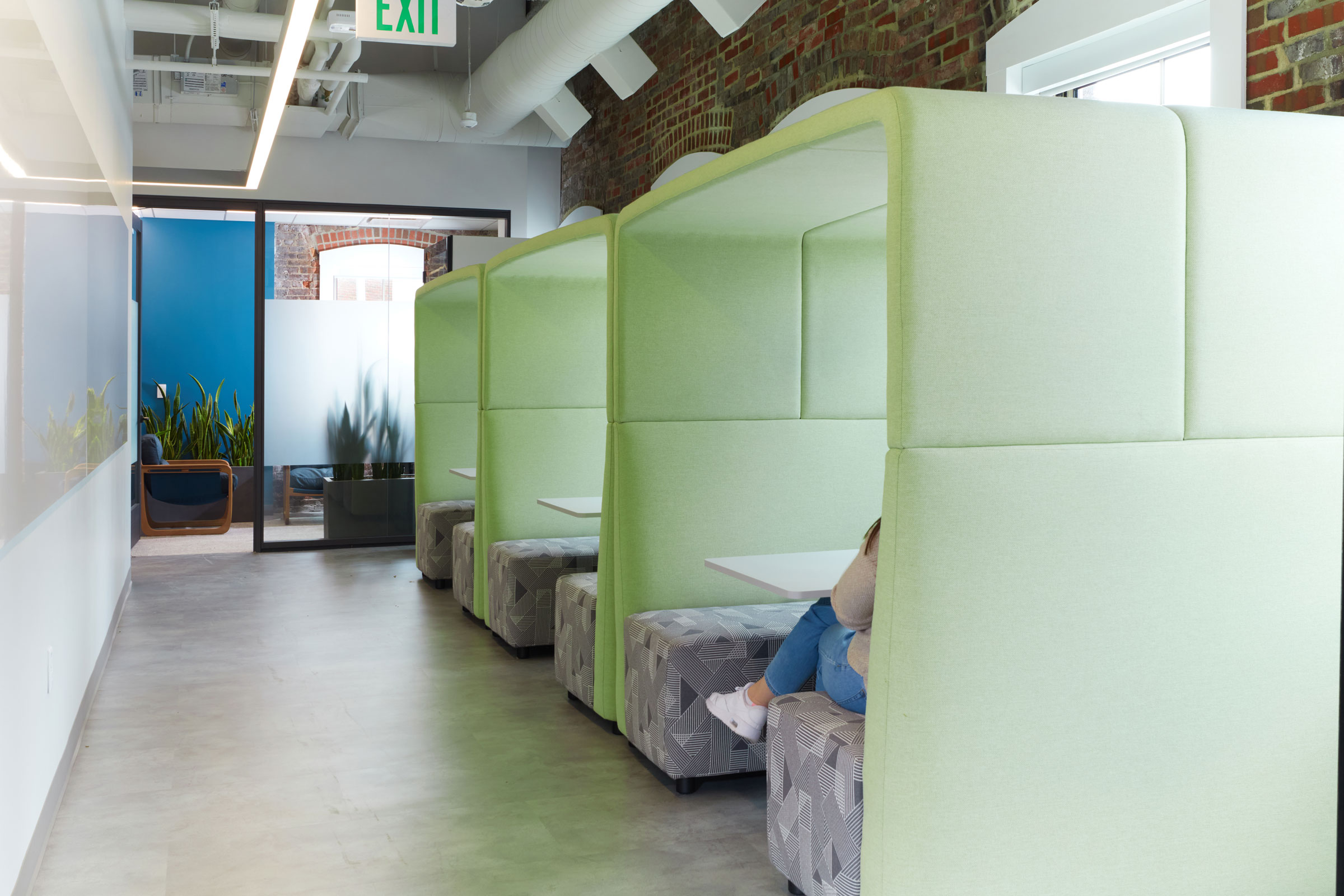
Photo by Chris Rogers
Since it unites three adjacent buildings, 20 Brattle Street required Dyer Brown to work closely with project engineers and developers to address emerging technical issues on a tight schedule.
“There were some really low ceiling height conditions,” Ross says. “In the middle section I think the floor-to-deck measurement is only about 13 feet. That may sound like a lot, but when you add redundant systems for airflow and air quality, it leaves a lot of the ceiling open or exposed.”
Floor heights also vary; the middle segment required the installation of an ADA lift to ensure accessibility. “It’s challenging, but it makes our projects unique,” Ross says. “It makes for a nice user experience, because it’s not a traditional high-rise office building due to its idiosyncrasies. A lot of little nooks and crannies makes it more like a campus building.”
While sustainable, 20 Brattle Street’s real innovation is how it accommodates its end users. “We’re trying focus more on the people occupying the space, because standard practice for Dyer Brown is to use sustainable materials,” Ross says. “That’s what we live and breathe.
“We’ve been talking about the quote-unquote ‘future of work’ for almost five years now,” she adds. “Offering variety, flexibility, and different ways to work—I don’t think that’s going away. You have to create the space for all types of people.”
Project Credits
Project: The Abbot
Location: Cambridge, MA
Completion: 2023
Size: 16,000 square feet
Designer: Dyer Brown & Associates
Developer: Regency Centers
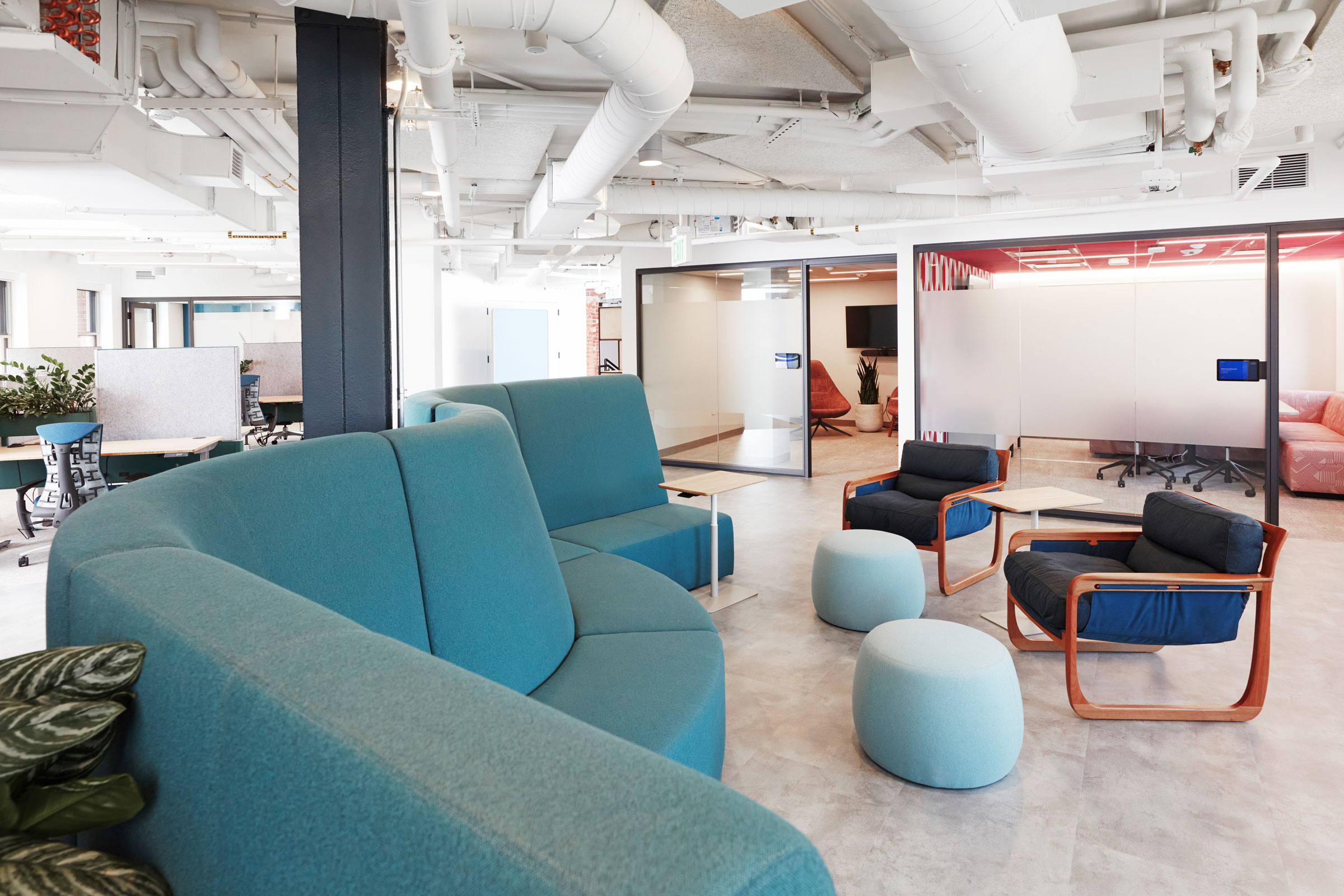
The Abbot features a variety of flexible seating options like traditional office chairs, lounges, and beanbag chairs. Photo by Chris Rogers
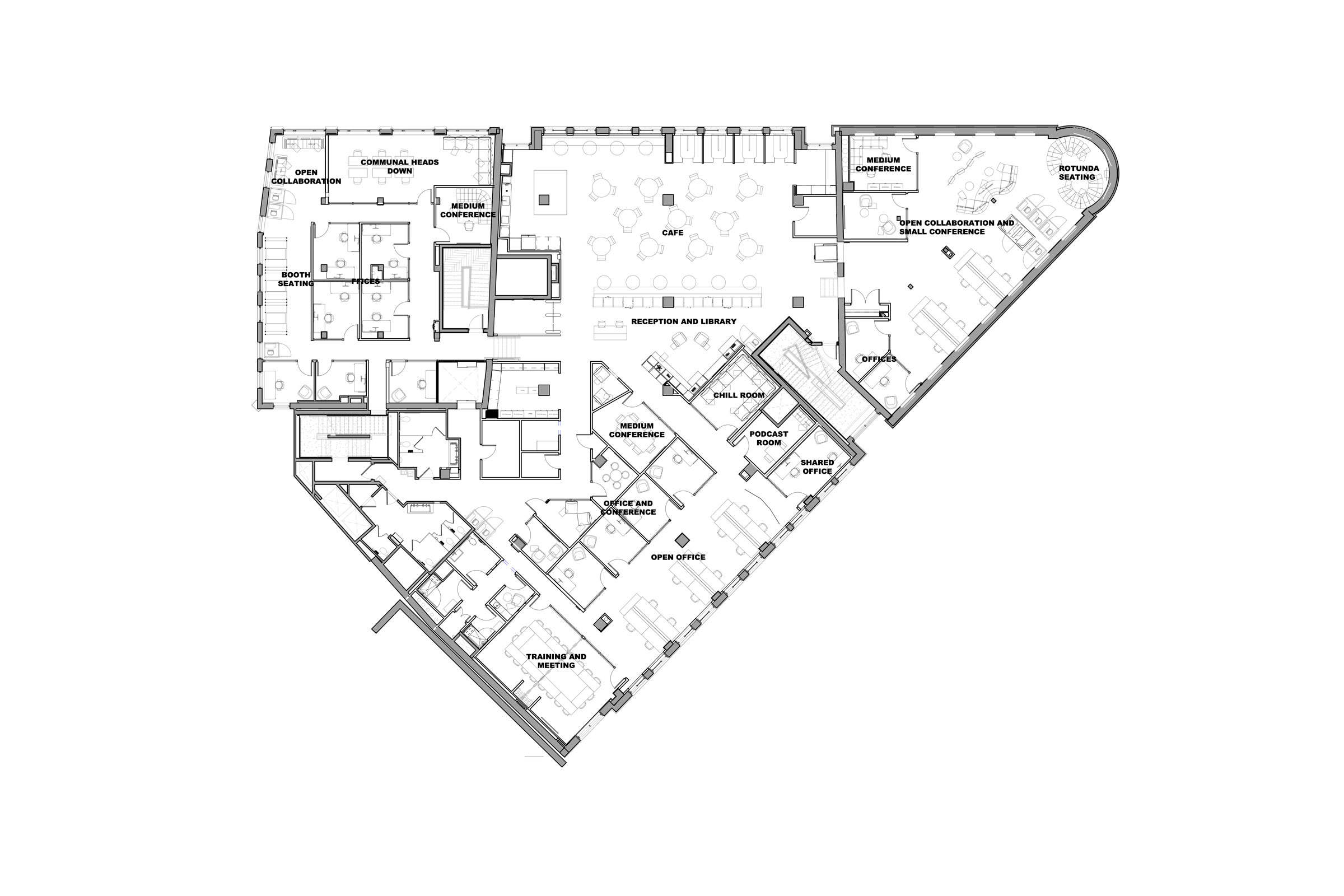
Floor plan courtesy of Dyer Brown

